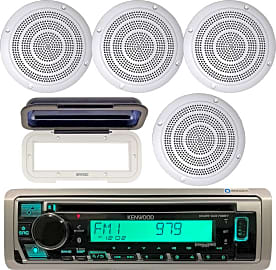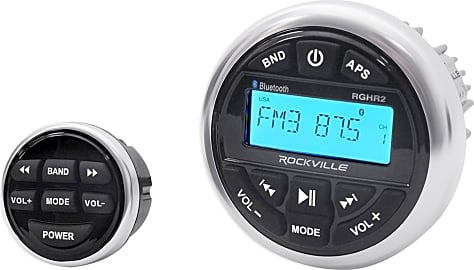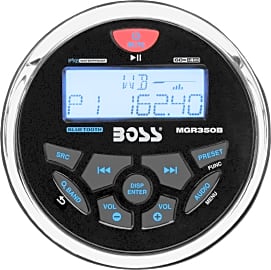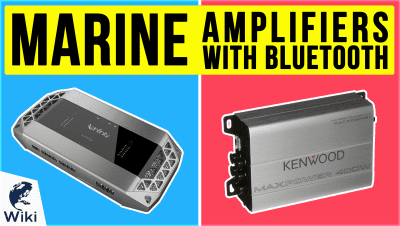The 10 Best Marine Stereos

This wiki has been updated 42 times since it was first published in October of 2016. If you are looking for a way to add to the entertainment options on your boat, then have a look at these marine stereos. They are capable of playing music and podcasts via Bluetooth, USB, and MP3 devices, and are also equipped with FM and AM radio tuners. We've ranked them here by their ease of setup, sound quality, and their ability to withstand harsh marine conditions. When users buy our independently chosen editorial selections, we may earn commissions to help fund the Wiki.
Editor's Notes
December 04, 2020:
While nearly all of the marine stereos in the original list were still available, many of them have been updated with newer models or just got too old. The JVC In-Dash was removed in favour of the Pyle Bluetooth Marine, which supersedes the JVC in every department, not least the size and scope of the bundle which includes four speakers, a remote control, and all the wiring and casing you need to install it.
The Kenwood KMR-D375BT simply replaces the previous unit, which is slightly outdated. Alexa and Spotify are welcome additions to any marine stereo, and many of the ones on our list also have dedicated apps that allow you to access and control your stereo from anywhere aboard. The size and shape of the Herdio Weather-Proof helped us add it to the list, as it will look fantastic next to your speedometer, rev-counter, and fuel gauges.
April 18, 2019:
Due to availability issues, we were forced to remove the otherwise very capable Clarion CMS2 from our ranking. It would have been nice to replace it with another model from this company, as they've made pretty high quality stuff for a number of years, but their latest unit is an attempt to introduce a large touchscreen navigation system to the radio, and the results are not impressive. Not only were there issues with the CPU speed, but the control knob notoriously failed due to poor sealing letting in water. Not exactly ideal on a boat.
Elsewhere, the Pyle model previously at number nine saw a huge promotion to our number two slot. It's possible that its quality was underestimated given its low price point, but a closer inspections has revealed an outstanding budget option. Taking our top spot, though, is a new model from Fusion, which is incredibly simple in both its installation and its interface, making it easy for anyone to set up and use.
Special Honors
Sony MEX-M100BT More expensive than many other marine stereos and supplied by a leading brand, the Sony MEX-M100BT features a built-in amplifier that pushes an impressive 160 watts. It is also satellite radio-ready, has its own dedicated app, and variable color illumination. The unit is Bluetooth compatible and voice-activated. sony.com
Why Boats Require A Marine Stereo
Unlike marine stereos, standard car receivers aren't built to withstand this kind of abuse.
Marine environments are harsh. The combination of sun, saltwater, extreme temperatures, wind, and constant impacts can wreak havoc on sensitive electronics. Unlike marine stereos, standard car receivers aren't built to withstand this kind of abuse. The unique physical make up of saltwater makes it highly conductive to electrical charges. Just a small amount of saltwater inside of a car stereo can quickly cause a short, and possibly a fire. In a boating environment, especially in power boats where the wind and sea spray is more forceful, it is inevitable that saltwater will enter your boat stereo at some point.
It isn't just shorts that are a problem for electronics in saltwater. Corrosion is also a major issue. The combination of saltwater and oxygen can quickly eat away at metals that aren't designed to withstand constant exposure to it. Saltwater corrodes metal five times faster than fresh water. That is why humans have invented marine grade metals, which have special alloying elements added that help to defend against corrosion.
Marine stereos are built with the harsh conditions of the open water in mind. Most will feature a water-resistant faceplate, and many include a water-resistant remote control, as well. As we mentioned previously, though, it isn't a question of if water will get into a marine stereo, but when. Even with a water-resistant faceplate, the combination of wind and sea spray will force water inside of your stereo at some point. This is why manufacturers make marine stereos with circuit boards that are covered with a conformal coating, made from silicone, acrylic, or some other polymer. Because of the flexible properties of these conformal coatings, they can get into all of the nooks and crannies of a circuit board and effectively create a water- and dust-resistant seal.
How To Choose A Marine Stereo
One of the first considerations when choosing a marine stereo must be the size of the existing stereo you are replacing. If you are putting a stereo into a boat that has never had one before and you intend to cut a new hole, this obviously doesn't matter. Most people, however, buy a new stereo to replace a broken our outdated model. In this case, it is important to buy one that fits within the current cutout.
It is important to look at the power specifications of any model, as well. Most boat owners don't plan on using an external amplifier, and expect their head unit to provide enough power to the speakers on its own. Unless you are planning on installing a large, complicated, and high-powered system with sub-woofers and an amplifier, you'll want a model that will push out enough wattage to produce good sound at high volumes.
Peak power is the amount of watts a stereo can produce at any given moment.
When reading the specs, you may see either peak power output or RMS. Peak power is the amount of watts a stereo can produce at any given moment. RMS is the average amount of power it can produce over time. Peak power is always higher than RMS. For example, a stereo with 50 watts peak power per channel, will generally have somewhere around 20 watts RMS per channel. Because of this, most manufacturers publish peak power specs, since they sound more impressive. For most users, models that output somewhere between 40 and 60 watts peak power per channel should suffice. Since most head units have four channels, that translates to a total peak power output between 160 and 240 watts.
If you have a large CD library, you would do well to choose a model that has a CD player. With the advent of digital music players, CD players are no longer standard in marine and car stereos, so if this is important to you, double check to make sure the unit you are considering has one. Also, take into account what type of connectivity options you need. There are units available that come with Bluetooth, AUX inputs, USB ports, and SD memory card slots. You can choose one with all of these, or try and save a little cash by choosing a model without any of these features if your budget is tight.
There are a couple of other features to consider, as well. If you have a cabin in your boat and want to be able to control your boat while below deck, or perhaps while fishing at the stern, a model that comes with a remote control will best serve your needs. A unit with oversized keys can be convenient and allow for easier control while cruising at high speeds. Determine your needs first, before making a purchase.
The Difference Between Marine Stereos And Marine Radios
Landlubbers and those new to boating often confuse the terms marine radio and marine stereo. To old sea dogs, the difference may be obvious, but it is not hard to see why it can be misleading for some. It is not uncommon when talking about a car stereo to refer to it as a radio. In fact, the two terms are practically interchangeable.
It is not uncommon when talking about a car stereo to refer to it as a radio.
A marine stereo is used mainly for music playback purposes. Some models may, of course, be used like a speakerphone, if they offer Bluetooth connectivity and have microphone support. Marine radios are devices capable of transmitting and receiving messages. They are used to communicate on set international frequencies, referred to as channels. In the United States, most of these channels fall within the 156 and 174 MHz spectrum. Marine radios can be used to summon help from emergency support services, contact bridge tenders to request an opening, and speak with captains of other vessels or marina personnel. They are also often used to listen to weather and sea reports.
According to United States regulations, only certain types of vessels fall into the compulsory equipped category and are required to have a marine radio on board. These include cargo ships over 300 gross tons, for-hire boats certified by the Coast Guard to carry more than six passengers into the open sea or tidewaters, power vessels over 60 feet in length, uninspected commercial fishing boats, and a few others. Most recreational boats fall into the voluntary equipped category, but despite this, it is still a smart decision to keep a radio on board.















